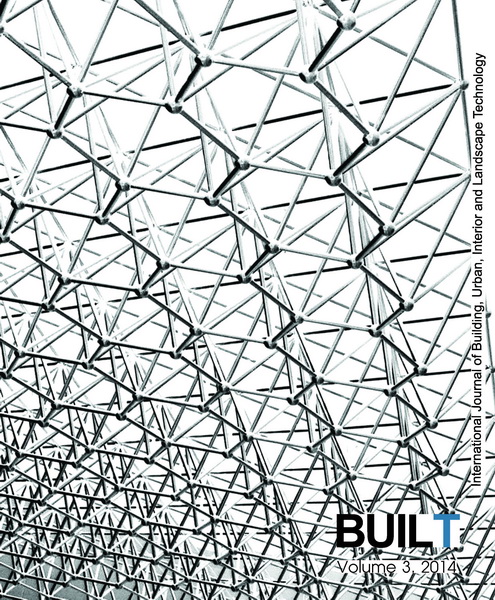Video Observation and Analysis of the Pavement Pattern’s Visual Impact on Pedestrian Walking Experience in Japanese Low Carbon Society
Keywords:
Transit Oriented Development (TOD), Mass transit, Land use, Urban planningAbstract
A combination of individual characteristics, infrastructure, and societal attributes defines the pedestrian walking experience. Walking is a complex phenomenon that should be and could be approached from various fields of scientific research. One of the approaches is within its visual impacts of the walking infrastructure. Increasing number of studies about walking phenomenon shows the importance of walking is being widely recognized as societies strive to implement the low carbon principle. Sidewalks now cover more than 150,000 km in modern Japanese cities. Average Japanese takes 7,168 steps per day. These numbers show how important a walking infrastructure in Japanese urban development.
Walking infrastructure in Japan has been well developed yet varied in its physical appearance especially its pavement pattern. Authors have documented more than 70 different types of pavement pattern in pedestrian areas from several cities in Japan. This research aimed to study the impact of pavement patterns as one of visual stimulations for the pedestrian by observing their walking movement and speed using video sampling and analysis by open source software, and also their awareness to different types of pavement pattern using direct yet non-paper based questionnaire. Totally 93 pedestrians were observed and 71 questionnaire responses were collected. The research then found that there were early indications of visual impact of pavement pattern in the case study which was in the area of Kitakyushu Science and Research Park (KSRP) at Hibikino, Wakamatsu Ward, Kitakyushu City, Japan.
Downloads
References
Azmi, D. I. & Karim, H. A. (2012). A comparative study of walking behaviour to community facilities in low-cost and medium cost housing. Procedia - Social and Behavioral Sciences, 35, 619-628.
Fujimoto, H. (2008). The modal shift to environmentally sustainable transport: Prospects of urban transport systems: LRT, BRT and Buses. Science & Technology Trends, 29, 46-61.
Iamtrakul, P., Satichob & Hokao, K. (2013). Comparing the effciency of urban components in proximity to transit service area. International Journal of Building, Urban, Interior and Landscape Technology, 2, 21-34.
Jewitt, C. (2012). An introduction to using video for research. London: National Centre for Research Methods.
Kwon, I. Y., Morichi, S. & Yai, T. (1997). Analysis of behaviors and interactions of pedestrians, bicycles and cars in narrow urban streets. Journal of the Eastern Asia Society for Transportation Studies, 2(3), 853-862.
Matsumoto, N. (2005). Development of environmentally sustainable transport systems in urban areas. (APEIS/ RISPO Final Report, pp. 208-256). Hayama: Institute for Global Environmental Strategies [IGES].
Ministry of Land, Infrastructure, Transport and Tourism Japan. (2011). Low carbon city development guidance overview. Japan: Author.
Nuzir, F. A. & Dewancker, B. J. (2014). Understanding the role of education facilities in sustainable urban development: A case study of KSRP, Kitakyushu, Japan. Procedia Environmental Sciences, 20, 632-641.
Nuzir, F. A. & Dewancker, B. J. (n.d.). From sustainable to low carbon city: Zero emission urban mobility in Japanese cities. N.P.: n.p.
Nuzir, F. A., Dewancker, B. J., Jing, S., Nakashima, Y., Lebreton, K. & Rahardi, Y. (n.d.). A Study of the Visual Influence of Pavement Patterns on Pedestrian Walking Behaviour in the KSRP, Kitakyushu, Japan. Paper of Conference: The 10th International Symposium on Architectural Interchanges in Asia (ISAIA), Kitakyushu, Japan. N.P.: n.p.
Pazhouhanfar, M. & Kamal M. S. M. (2014). Effect of predictors of visual preference as characteristics of urban natural landscapes in increasing perceived restorative potential. Urban Forestry & Urban Greening, 13(1), 145-151.
Regional Revitalization Bureau, Cabinet Secretariat, Government of Japan. (2009). The eco-model city project and future directions. Paper of the International Conference on Promoting the Low-Carbon Cities, 5 October 2009, Yokohama, Japan.
Schipper, L., Deakin, E. & McAndrews, C. (2010). Carbon dioxide emissions from road transport in Latin America. In Daniel, S. & James, S. C. (Eds.), Climate and transportation solutions. California: Institute of Transportation Studies University of California.
Tsukaguchi, H., Yeh, K-U., Vandebona, U. & Ching Hsia, H. (2010). Comparative study of pedestrian travel culture in different cities in Japan. Journal of the Eastern Asia Society for Transportation Studies, 8(1), 1164-1178.
World Business Council for Sustainable Development. (2004). Mobility 2030: Meeting the challenges to sustainability (The Sustainable Mobility Project). Geneva, Switzerland: Author.
Downloads
Published
How to Cite
Issue
Section
License

This work is licensed under a Creative Commons Attribution-NonCommercial-NoDerivatives 4.0 International License.












